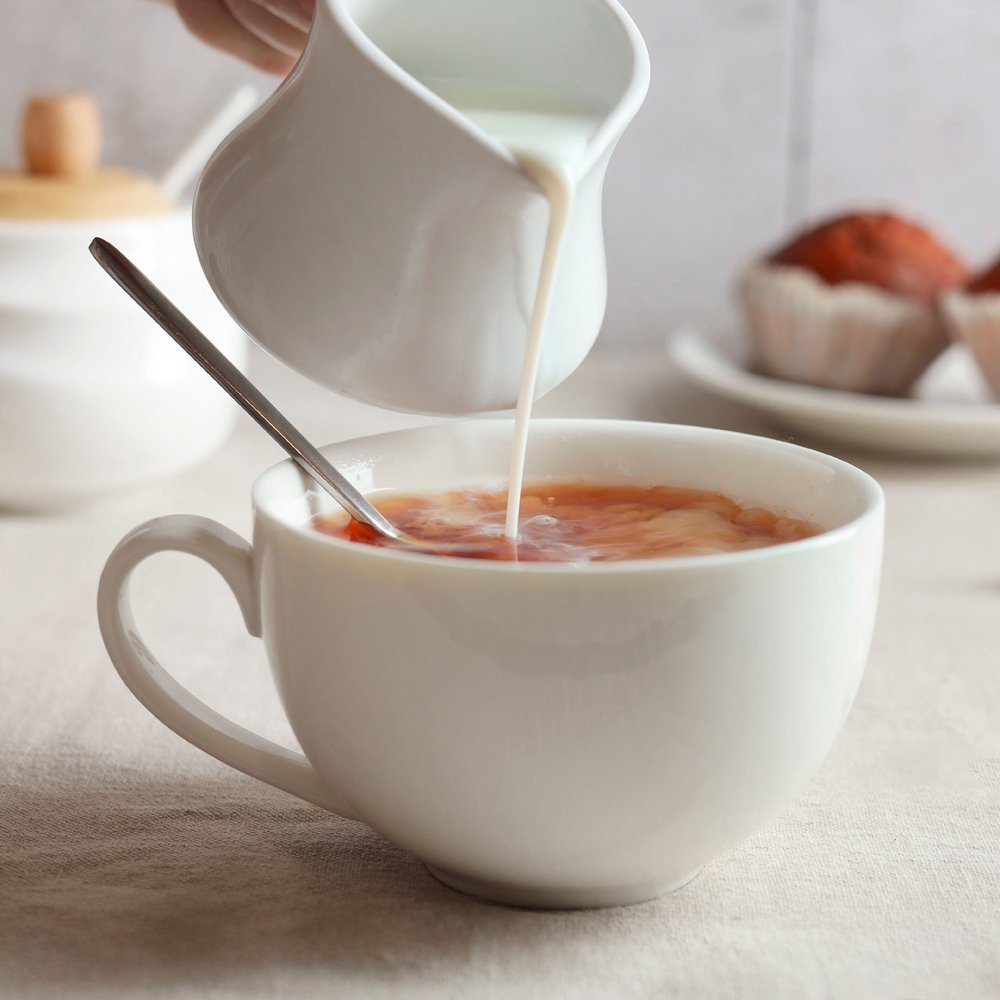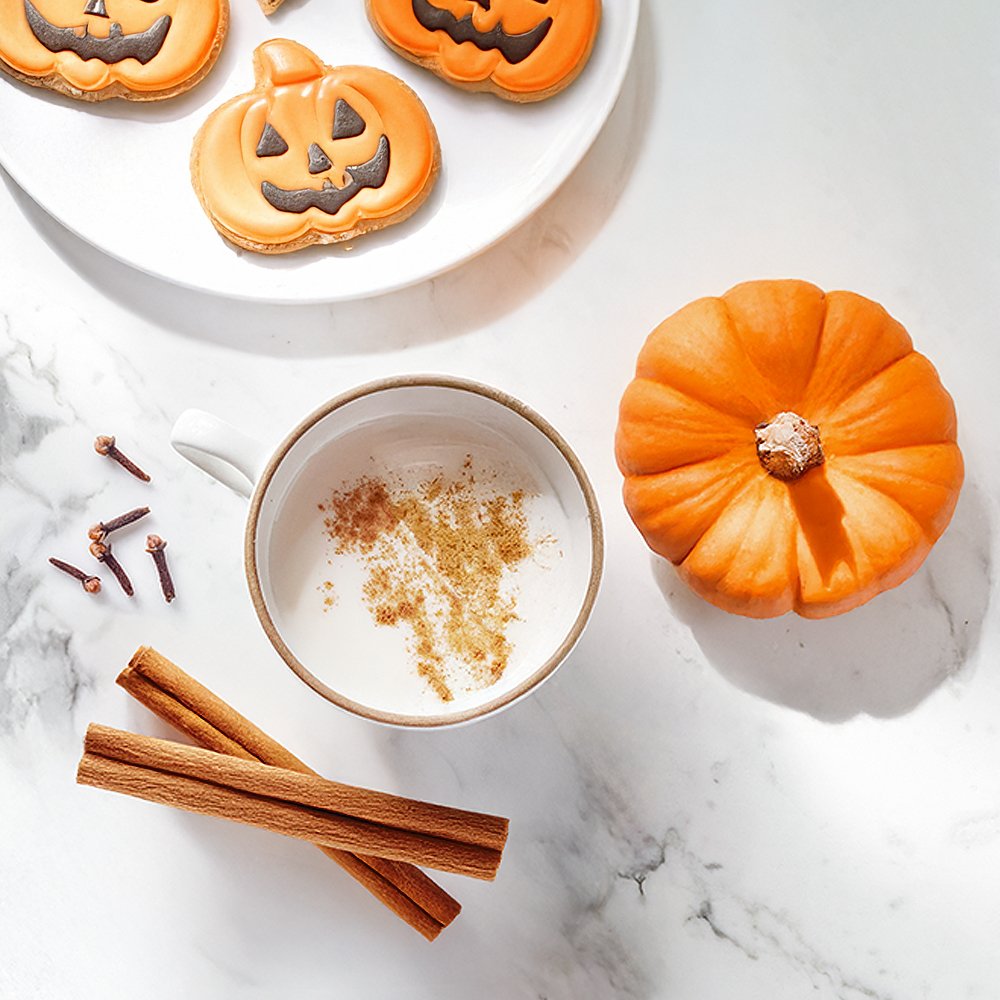Whether sipped at daybreak to help wake up your senses or savored in the afternoon with a pastry for a quick pick-me-up, there is nothing like a warm cup of chai. Taking a deep breath of its rich, peppery scent entices first-time sippers and long-time tea-enthusiasts alike.
But what exactly makes this flavorful drink so unique? What is in chai tea that sets it apart from the rest in your stash of tea?
The answer is a remarkable blend of ingredients, beginning with a black tea base. Read on to learn more about this cozy beverage.
What Is Chai Tea?
What is in Chai tea? This tea has been around for thousands of years. It was initially made in India as a mix of spices without tea leaves as an herbal remedy. British colonizers added black tea in the 1800s in an attempt to popularize the crop they had just added to their empire.
Where does chai tea come from?Chai comes from the term masala chai, a Hindi phrase meaning “spiced tea.” When it became popular elsewhere, it was shortened to simply chai. (So yes, “chai tea” literally translates to, “tea tea.”)
Chai’s ingredients come from all over the world and it can be enjoyed in many forms. It can be prepared on its own, but is perhaps most popularly enjoyed as a latte – either Hot or iced. Chai can be made on its own or as a latte—hot or iced. There are even special varieties of chai like Apple Pie Chai and chai blended with Matcha.
Typical Ingredients of Chai
The specific ingredients in chai may vary slightly between producers and regions. However, these are the most widely used ingredients found in a masala chai:
- Tea – What we know of as chai would not be quite the same without tea leaves. Black tea is by far the most common, with Darjeeling and Assam being the most typically used in chai blends. But did you know chai can also be made with other types of tea? Chai can be made with green, white and rooibos teas as well to cater to different individual tastes or as lower caffeine options.
- Ginger – Ginger’s light, almost spicy flavor helps to balance out the strong warm aromas of the other ingredients. Ginger is believed to be native to Southeast Asia, though India is a top producer of the herb.
- Cinnamon – A fall staple, cinnamon brings an abundance of flavor to this beverage. Although people enjoy teas year-round, just a hint of cooler weather will make you that much more excited about setting your tea kettle on.
- Cardamom – Cardamom, which originated in India’s southern forests, is essential to chai’s signature taste. It comes from the pods of the cardamom plant, which is related to ginger and turmeric, as all are part of the Zingiberaceae family. It is dried after harvest, either naturally in the sun or by machine.
- Clove – Cloves bring a distinct flavor and aroma wherever they are found. This spice comes from the buds of an evergreen tree native to Indonesia. After they are harvested, they take on a dried form as a unique ingredient that goes into some favorite dishes and teas.
- Peppercorn – Black pepper is definitely the spiciest ingredient in traditional chai. In full leaf teas, peppercorn tends to be left whole, not ground. Different varieties of chai contain varying levels of heat, based on the type and quantity of whole peppercorns added.
Additions That Can Be Made to Chai
Chai is sometimes prepared and served on its own, but it is frequently pulled together with these other ingredients to make its taste that much more enjoyable:
- Milk – The boldness of chai is typically balanced out with steamed milk to give a creamy, rich flavor. This practice originated from those selling tea in Indian markets who wanted to keep their costs low, as the price of British black tea was so expensive. Adding milk to your chai can also give it a bit of protein, perfect for a boost of energy in the morning. Using non-dairy alternatives such as soy milk, oat milk, coconut milk or almond milk is also popular.
- Sweeteners – Chai can be sweetened with honey, sugar or other sweeteners.
- More Spice – Another way to spice up your chai is to add a little more of something already in the real chai tea blend. An extra dash of cinnamon, ginger, or cardamom adds another layer of flavor, and you might even get more health benefits from your chai — more on that later!
The Flavor Profile of Chai
So how to taste tea the right way? A flavor profile is a description of a food or beverage, in this case, tea. First, we might start with the fact that chai is considered both spicy and sweet. We might also include in a flavor profile words like body, mouthfeel and aroma.
- Body – We often call chai full-bodied, meaning it tastes strong and somewhat heavy.
- Mouthfeel – Mouthfeel is just as it sounds — how the tea feels in your mouth. Does the tea have a light and airy feel or heavy and creamy?
- Aroma– Aroma may more typically be used to describe the scent of coffee, but for our purposes, it can also be applied to tea. Which chai tea enthusiast has not opened up their tin of tea and been happily met with a rich, sweet, spicy aroma?
Does Chai Tea Have Caffeine?
Does chai have caffeine?Chai tea is a black tea, meaning that, yes, it is a caffeinated drink. One eight-ounce cup of black tea has around 50 milligrams of caffeine compared to a 8 ounce cup of coffee, which contains around 120 milligrams. A little caffeine makes chai a superb choice for a morning or afternoon go-to.
Because black teas contain significantly less caffeine than coffee, the amount that stays in your system hours after drinking it will be less. That means that at night, your body might not experience the same negative effects it would after an afternoon coffee. L-theanine, a non-protein amino acid present in tea, offers a gentle caffeine boost that is more steady and less jittery than with coffee or espresso.
Chai made with green tea instead of black has even less caffeine, which makes it a good choice if you are wanting to cut back on your caffeine even more.
Is Chai Tea Healthy For You?
Is chai tea good for you? We typically associate tasty treats with being unhealthy. As delicious as it is, chai is packed with health benefits. Chai can positively impact the sipper’s health by:
- Easing upset stomach – Ginger is known for helping ease nausea related not only to general queasiness but motion sickness and morning sickness as well.
- Lowering blood pressure* – Did you know that a cup of Indian chai tea can be heart healthy? Cinnamon and ginger work together to lower blood sugar levels.* Cardamom has also been found to give this benefit.
- Lowering blood sugar – The cinnamon in chai can help lower blood sugar as well as the risk of diabetes-related complications because it mimics the effects of insulin.
- Improving brain function – If you have not guessed it already, cinnamon is a star when it comes to assisting your body in being its best. Turns out, it could help your brain be at the top of its game too. That is because cinnamon has been found to improve memory and cognitive function. In chai, paired with the caffeine of black tea leaves, cinnamon can also help improve focus. The L-Theanine present in chai tea has been proven to support cognitive function. In a study conducted by the Journal of Medicinal Food, the group given a single dose of L-Theanine had higher attention than the placebo group.
- Clearing sinuses – Have you ever heard that eating spicy foods is good when you have a cold? That is because the capsaicin in spicy foods and drinks interacts with your system by breaking down mucus and eliminating sinus blockage. Drinking chai might help you feel more cleared up when dealing with a head cold.
Find All Things Chai at The Republic of Tea
Are you ready to fall in love with chai all over again?
The Republic of Tea offers a delightful selection of chai tea products, including both loose leaf and bagged teas, concentrates, and other chai-inspired treats, like our Chai Spice Honey for Tea.
Steep your next cup of chai from The Republic of Tea with a new understanding of this treasured, timeless Indian chai tea.
Sources:
Baba, Yoshitake et al. “Effects of l-Theanine on Cognitive Function in Middle-Aged and Older Subjects: A Randomized Placebo-Controlled Study.” Journal of Medicinal Food 24 (2021): 333 – 341.
theSpruceEats. The History of Masala Chai.
https://www.thespruceeats.com/the-history-of-masala-chai-tea-765836
Register Guard. CAFE 541: Why the Name Chai Tea’ Is Incorrect and What Masala Chai Really Is. https://www.registerguard.com/entertainmentlife/20200204/cafe-541-why-name-chai-tea-is-incorrect-and-what-masala-chai-really-is
Food and Wine. What is Chai and How to Make It.
https://www.foodandwine.com/tea/chai-tea/what-is-chai-how-to-make-chai
Vikaspedia. Ginger.
https://vikaspedia.in/agriculture/crop-production/package-of-practices/spices/ginger
Britannica. Cardamom. https://www.britannica.com/plant/cardamom
Indian Institute of Spice Research. Cardamom, Ginger, and Turmeric.
http://www.eolss.net/sample-chapters/c10/e1-05a-49-00.pdf
McCormick Science Institute. Cloves.
https://www.mccormickscienceinstitute.com/resources/culinary-spices/herbs-spices/cloves
Whole Life Challenge. Learn to Play the 3 Flavor Notes.
https://www.wholelifechallenge.com/whole-life-challenge-home-cooking-boot-camp-week-8-flavor-notes/
Mayo Clinic. Caffeine Content for Coffee, Tea, Soda and More.
Indian Mirror. Ginger. https://www.indianmirror.com/ayurveda/indian-spices/ginger.html
Healthline. 10 Herbs That May Help Lower High Blood Pressure.
https://www.healthline.com/nutrition/herbs-to-lower-blood-pressure#10.-Cardamom
Healthline. How Cinnamon Lowers Blood Sugar and Fights Diabetes.
https://www.healthline.com/nutrition/cinnamon-and-diabetes
Modi, K.K., Rangasamy, S.B., Dasarathi, S. et al. Cinnamon Converts Poor Learning Mice to Good Learners: Implications for Memory Improvement. J Neuroimmune Pharmacol 11, 693–707 (2016). https://doi.org/10.1007/s11481-016-9693-6
Rochester Regional. Spicy Foods and Your Health.
https://hive.rochesterregional.org/2020/02/spicy-food-health






